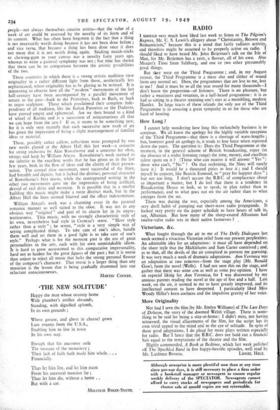MUSIC
WHAT is originality in a work of art ? Is it always a question of manner, of saying old things in a new way, or arc there really new things to say ? All the arts have lately gone through a phase of would-be renovation, and it has been an article of faith among many people—not always themselves creative artists—that the value of a work of art could be assessed by the novelty of its form and of its content. What has often been forgotten is the fact that a thing is not necessarily worth doing because it has not been done before ; and vice versa, that because a thing has been done once it does not mean that it is not worth doing again. Sticking match-sticks or chewing-gum to your canvas was a novelty forty years ago, whereas to write a pastoral symphony was not ; but time has shown that there can be no comparison between the artistic possibilities of the two.
Those countries in which there is a strong artistic tradition view originality in a rather different light from those, aesthetically less sophisticated, where originality has to be glaring to be noticed. It is interesting to observe how all the " modern " movements of the last half-century have been accompanied by a parallel movement of return to the past—back to the Primitives, back to Bach, or back to negro sculpture. Those which proclaimed their complete inde- pendence of all tradition, like the Italian Futurists or the Dadaists, have proved empty and ephemeral. Are we then bound to a kind of wheel of Karma and is a succession of reincarnations all that we can hope from the arts ? If so, it seems to be something new, for it is only very recently that each successive new work of art has given the impression of being a slight rearrangement of familiar ideas or material.
These, possibly rather callow, reflections were prompted by two new works played at the Albert Hall this last week—a concerto for string orchestra by Alan Rawsthome and a concerto for oboe, strings and harp by William Alwyn. Rawsthornc's work seemed to me inferior to the excellent works that he has given us in the last few years, both in the flow of ideas and the clarity of their presen- tation. The central slow movement, most successful of the three, had breadth and dignity, but it lacked the distinct, personal character of Rawsthornc's best music, while the contrapuntal writing in the other two movements gave me the impression of being artificial, devoid of real drive and meaning. It is possible that in a smaller building this music might make a more distinct mark, but in the Albert Hall the lines seemed blurred and the effect indeterminate.
William Alwyn's work was a charming essay in the pastoral romantic manner so well suited to the oboe. It was not in any obvious way "original" and part of its charm lay in its unpre- tentiousness. This music, with no strongly characteristic style of its own, nevertheless had style in Cocteau's sense. "Have style rather than a style " ; he wrote, " style is a very simple way of saying complicated things. To take care of one's ideas, handle them well and set them in a good light is to take care of one's style." Perhaps what is for the moment past is the era of great personalities in the arts, each with his own unmistakable idiom. It is hard to grow accustomed to this comparative impersonality, hard not to hanker for the great figures of the past ; but it is worse than unjust to reject all music that lacks the strong personal flavour of the composer's character. That music is a larger thing than any musician is the lesson that is being gradually drummed into our reluctant consciousnesses.
MARTIN COOPER.



































 Previous page
Previous page